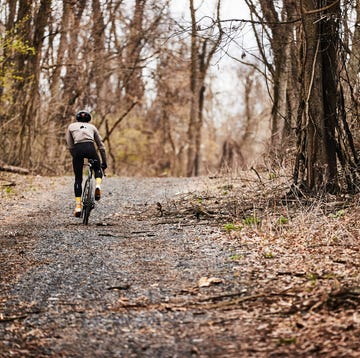Q: What is enduro racing? I keep hearing people talk about it at the trailhead.
This relatively new style of mountain bike race separates a course into uphill and downhill sections, but only the descents are timed. Many events send competitors down steep, rugged terrain, so descending skills are critical. But riders also need short bursts of power to speed over short climbs and stamina to summit the untimed ascents. That means enduro racers need to be versatile. "You have to be good at climbing and descending, have bike-handling skills, and be able to jump," says Kirt Voreis, a former dual-slalom national champion who now competes in the Enduro World Series. "It's also a friendly style of racing because after you compete alone against the clock, you can discuss your runs with racers on the climbs. Enduro encourages a sense of camaraderie because it feels like you're all playing the same game." The format started in Europe roughly a decade ago, but has gained global popularity in just the past two years. Most regions of the United States now have their own events, which can last from several hours to several days, so there's something for almost everyone.
How do you patch an inner tube? Will it be as reliable as a new one?
Before you patch, inspect the tire for tears or puncture-causing objects. Then locate the hole in your tube by partially inflating it and rotating it close to your ear to listen for escaping air. Now you are ready to get to work. Patch kits come in two common varieties. The quicker of the two contains stickerlike patches that adhere in seconds. "That's a fast repair, but it's only intended to get you home," says Paul Schoening, director of marketing at Park Tool. The other variety requires you to apply glue between the patch and tube. It's a permanent fix, but the adhesive takes longer to dry. This method requires that you first scruff the rubber around the puncture with a roughening device included in most kits. Next you apply the glue, but wait until it looks dry before pressing on the patch, and don't inflate the tube until it's in the tire. Patches cost less than new tubes and waste less material, but we don't recommend them for races or other events in which you need a quick tire change. And it's wise to carry a tube on any ride that you risk multiple punctures. "Everyone should have a new tube with them," Schoening says, "and a patch kit as a backup."
When passing a cyclist or pedestrian, should I call out "On your left!" or ring a bell?
Cycling etiquette (and some mountain bike trail systems) dictate that you give an audible warning when passing, says Andy Clarke, president of the League of American Bicyclists. So either way works. Some riders believe that the cheery ding of a bell is friendlier than shouting, and it also cuts through noise better. "I use my bell when I see people with earbuds or who are lost in their phones," Clarke says. "If it's a bicyclist ahead, I tend to use my bell from farther back." Avoid barking "On your left!" which seems not only rude, but also can backfire if you startle the target, who jumps to the left. A cheerful "Coming around!" often goes over better. Just be sure to give a wide berth when passing.
Do I really need gloves? They get so sweaty, and they stink!
It depends on riding conditions and your preference. In hot weather, gloves absorb sweat and can prevent your hands from slipping off the handlebar. They also provide a layer of padding that can dampen road rattles. But the cushioning makes it harder to sense what your bike is doing, so some riders go gloveless. "I race with them on the road, but I almost never wear gloves for cyclocross because I like to have a better connection with my bike," says Meredith Miller, a professional cyclist from Boulder, Colorado. Miller also wears gloves for extra protection when mountain biking. "I'm more prone to crash on a mountain bike," she says. If you find full-finger gloves too hot, consider fingerless ones, sometimes called mitts, that have a padded palm and breathable mesh top. Or go gloveless and use a stickier bar tape, such as those from the Lizard Skins DSP collection. To prevent your gloves from stinking, wash them with your kit--every time. For truly offensive odors, try GO Soap, which is made for sports apparel, or add a cup of white vinegar to your laundry.
Ask Bicycling: Enduro Racing, Patching Tubes, and Gloves
All your ride quandaries, solved

Watch Next

Advertisement - Continue Reading Below

Does Ideal Cadence Really Exist?

How to Go from the Couch to Century

6 Long Distance Cycling Tips You Need

Do You Really Need a Power Meter?
Advertisement - Continue Reading Below
Advertisement - Continue Reading Below







